This article is continued from the previous page… Click here to jump Back to the Beginning.
Gun Safe Bolt Work
The term bolt work refers to the locking bolts which hold the gun safe door closed, the linkages and handle which move the locking bolts, the linkage immobilized by the lock deadbolt, and any relockers or other security features.
Bolt Work Design
Bolt work in many gun safes is very complicated and intricate. Often it is unnecessarily complicated
Impressive looking bolt work may have lots of moving parts, locking bolts, and gears. But this is generally included to wow buyers, not to make the safe more secure. Even 100 locking bolts on a door made of thin bent sheet metal isn’t going to keep a thief out very long.
The bolt work should be as simple as possible.
Anyone who has ever used electronic or mechanical devices under pressure or in combat can attest that simpler is usually better. Fewer moving parts means fewer binding and lubrication points, and fewer failure points.
Locking Bolt Number and Size
There is no locking bolt size currently available on a gun safe which is too small. But, almost all gun safe door jambs are too weak. So, don’t pay attention to the locking bolt size.
The number and size of locking bolts doesn’t really matter. Some of the best safes in the world have only 3 fixed locking bolts on the hinge side and 3 moving locking bolts on the other side.
What matters is the design of the locking bolts, and how well they are supported by the door itself.
Especially important for gun safes is the resistance of the locking bolts to being bent by a prying attack. In a pry attack the bolt work must prevent the locking bolts from being bent towards the front door panel as the door is getting pried open.
Locking bolts which extend far inside the door or thick bolt carriages supply a lot of leverage to resist prying. Alternatively locking bolt bar gussets and anti-pry tabs can make a big difference in a pry attack.
Of course all of the anti-pry features in the world will make no difference if the door and door frame is too weak to resist deformation.
Shear Pins and Clutches
Most gun safe bolt work is so delicate it can easily be damaged by excessive force on the door handle. Instead of beefing up the bolt work, manufacturers use a cheap workaround.
Their goal is to limit the amount of force which can be applied to the bolt work by the locking handle, to protect the bolt work. The most common methods are shear pins and clutches.
Shear pins are common on outboard motor propeller shafts and other power equipment. When used in a gun safe, a small hole is drilled into the internal bolt handle shaft to insert a pin. This pin transmits all of the rotational force to the bolt work.
If enough force is applied to the bolt handle, the shear pin breaks. This causes the bolt handle to spin freely and often come off. Shear pins are one-shot devices. Once they’re broken, you will need a safesmith to drill open your gun safe.
A broken shear pin can be infuriating. So, many gun safes come with clutches instead. Unfortunately a broken clutch can also be infuriating.
A clutch mechanism between the handle and bolt work will allow the handle to spin freely once enough force has been applied. The nice thing about a clutch is that it’s not a one-shot device like a shear pin. In theory, the clutch allow just enough force to be applied to open an unlocked gun safe, but not enough to break the bolt work. If a clutch fails you’ll still need a safe technician to drill open your gun safe.
Some clutches need to be adjusted after first installation by a safe technician. Unfortunately clutches are most common on lower cost gun safes. Lower cost gun safes are usually installed by the owners themselves, so these clutches often never get adjusted.
Failure of shear pins or clutches is not uncommon. Your child may hang on the handle, or play pirate ship with the locking wheel of your gun safe. You may close the door on a rifle sling or empty cartridge case, and need extra force to retract the locking bolts. A shear pin may break before the door open. A clutch may prevent you from getting enough force.
Bolt work should be robust enough to withstand a large amount of handle pressure without clutches or shear pins.
The bolt work of true safes is designed so that it will not fail catastrophically in a brute force attack. The handle may break off. But even a pipe wrench on the locking handle shaft shouldn’t damage the bolt work enough to open the safe, if it’s damaged at all.
Hinge Side Bolts
Any gun safe with external hinges must have hinge side locking.
If the gun safe you’re looking at doesn’t have hinge side locking, run — don’t walk — away. If the hinges are cut the door will fall off.
Locking bolts on the hinge side do not have to move. For simplicity fixed hinge side locking bolts are better. As an alternative, the door may have a tongue or wedge welded on the hinge side. The point is to clamp the door shut and prevent it from being opened if the hinges are removed.
Anti-Drill Hard Plate
An anti-drill plate or hard plate is used to protect the lock and main relocker from drill attacks. This small plate made of a hardened material is most commonly used to shatter, bind, or otherwise disable drill bits and other boring tools before they reach the lock.
To work properly, a hard plate must be free floating, properly hardened, preferably circular (to spin), and cover the entire lock and primary relocker. Some safes alternatively include a cavity of loose ball bearings behind the hard plate.
The box that the combination lock sits in should be mounted to a frame welded to the door. The hard plate should be slid in between the lock and the door skin so that it sits at an angle to incoming drill bits. The hardness, angle, looseness, and circular shape of the plate are designed to prevent the drill bit from getting enough purchase. Failing that, the intention is to bind up the pointed tip of the drill bit and snap it.
A hard plate is important, but doesn’t add much security to a gun safe with inadequate steel.

The uranium plated anti-drill plate and ballistic titanium relockers were still intact after burglars just sawed open the top of this gun safe.
The point of a hard plate is to protect the most vulnerable area of the safe to direct access. However this only really works if the steel of a gun safe is thick enough that drilling holes is time consuming.
The sheet metal of most gun safes is so thin that a large circle of holes can be quickly drilled and punched out on any side of the gun safe. Even that would take more time than prying open the door, or hacking through the wall with an ax or Sawzall.
Hard plates are a common marketing point on gun safes. It is much cheaper to include a small magical kryptonite plate hardened to 10,000 Rockwell C, than it is to put more actual steel in the walls and door. Instead of talking about how thin the steel sheet in their safe is, they distract you by bragging about the hard plate.
Relockers
Relockers are designed to permanently immobilize the bolt work if tampering is detected.
The most important location for a relocker is on the lock assembly itself, which is one of the more fragile parts of the bolt work. Most mechanical dial locks will get hit with a hammer or pry bar during a break-in.
Locks rated UL 768 Group I, and many Group II’s, have internal relockers. These will immobilize the lock deadbolt if the shaft is punched out. Usually this relocker is activated when the lock’s rear cover is broken off by the shaft punching through. The lock bodies also may be scored to break and activate other relockers if the lock assembly is dislodged, damaged, or the lock deadbolt is compromised.
The most common types of bolt work relockers include hardened spring loaded plungers connected to fragile steel cables. Cutting or punching attacks are designed to sever the cable and trigger the relocker. Other relockers are jarred by severe impact or triggered by high temperatures like torch attacks. Some relockers use glass plates to protect from drill attacks, which shatter the glass and trigger the relocker.
If a relocker is tripped, you will need a safe tech to open your gun safe. He’ll use manufacturer blueprints to drill and extract each relocker. once he opens the door, he/she’ll have to repair the damage if possible.
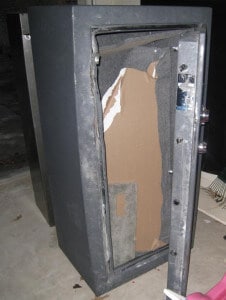
Relockers don’t do any good if the locking bolts and structure are so weak they can be pried open without retracting the bolts.
All gun safes should have some sort of relocker. But, they don’t add much security to a gun safe unless the steel in the walls and door is adequate.
For relockers to be useful, it has to be difficult to just hack through the walls, or pry open the door. If a relocker is tripped it will prevent the locking bolts from being retracted. But if the relocker is just spot welded to a thin metal door, it may just rip out anyway. Most gun safes can be pried open with the bolts extended, in which case a relocker is useless.
Much like hard plates, gun safe manufacturers love to brag about the number of relockers they have. Relockers are much cheaper than putting more steel in the walls and door of a gun safe. Because of this they’re added mostly for marketing value.
On true safes, relockers are beneficial. True safes have enough steel that drilling them is time consuming. So, would-be thieves must be strategic about where and why they’re attacking.
Safes rated TL-15 and higher often come with some randomization in the bolt work construction. The relockers and other components are installed in different random locations. This make even a skilled drill attack from a thief with safe technician blueprints more difficult.
Bolt Work Handle
The type of locking handle is often an option on gun safes. Fancy chrome or gold plated wheels are offered as upgrades. To each their own — if you like these better by all means go for them. With that said…
It’s better to skip fancy handles and spend the money on a better gun safe instead.
Any type of handle will allow you to open your gun safe. Many real safes are utilitarian and have simple lever handles.
To me, anything which attracts attention to a gun safe is bad.
Lever handles make a gun safe easier to camouflage as an electrical cabinet or chemical locker. Multi-spoke handles make it obvious that this is a gun safe.
If you’re concealing your gun safe in a closet to improve its security you’re not going to be able to admire a fancy handle anyway.
Gun Safe Fire Rating
Fire ratings are covered in detail in 9 Myths about Gun Safe Fire Ratings.
If you’re looking at conventional gun safes with fire protection, compare the construction of the fire protection and ignore any rating (other than UL 72).
No currently sold conventional gun safe carries the minimum true Fire Endurance rating of UL 72 Class 350. How well a gun safe will do in a fire depends on:
- Fire insulation
- Type of fire insulation
- Structural integrity and reinforcement of fire insulation
- Thickness of fire insulation
- Coverage of fire insulation
- Sealing of the body – non-continuous body welds will open up and let hot gasses and smoke in.
- Sealing of the door – intumescent door seals are a must.
- Structural integrity of the body and door – the body and door must be strong enough to resist buckling and deformation due to high temperatures. They may have to protect the gun safe from falling beams or falling through floors in a fire as well.
- Thickness of steel in the outer shell – in addition to maintaining the gun safe’s structural integrity, thicker steel adds more thermal mass to slow down the temperature rise and heat transfer in a fire.
Fire Insulation Type
Get the best type of fire insulation you can afford. In descending order from best to worst, here are the most common fire insulation types
- Poured concrete amalgamate (best)
- Ceramic wool fiber or high temperature fiberglass
- Fiberglass-reinforced gypsum drywall fireboard
- Standard paper-backed gypsum drywall (worst)
Insulation materials that offer some structural support to a gun safe, like poured concrete amalgamate, are best. These allow a minimum of heat transferring steel gusseting between the inner and outer shells of the safe.
Gypsum fireproofing will fall apart in a fire. If you’re going to go with gypsum drywall based fireproofing, high temperature fiberglass or any other reinforcement which helps holds the drywall together will offer more protection.
Another issue with gypsum drywall is that it can fall apart due to age and interfere with the bolt work. This is not an uncommon cause of safesmith service calls.
Fire Insulation Thickness
It’s not rocket science…
For a given material the thicker the fire insulation the better.
A gun safe with 1.5″ of gypsum drywall fireproofing will provide more protection than a similarly sized gun safe with only 1″ of the same material. This is true regardless of the manufacturers’ imaginary self-rated fire ratings.
The more continuous the fire insulation the better. Multiple gypsum drywall sheets should have interlocking and overlapping edges to help block the transfer of heat.
Beware of any cutouts or thin points in the fire insulation. Fewer heat-transmitting steel gussets connecting from the outer shell to the inside is better for fire protection. Of course fewer gussets is worse for burglary protection.
Steel Inner Fire Liner
A properly made fire safe will have a continuously welded inner shell.
The shell protects the contents of the gun safe from moisture released from the fire insulation. In a fire it also provides a barrier to prevent the exchange of the heat and steam released by the fireproofing, and the air inside the safe.
Steel inner shells are not found on conventional gun safes, which barely have much steel in the outer shell.
Other Gun Safe Features and Considerations
American Made Gun Safes, Made In USA
Buying an American made gun safe is a good idea. Primarily it supports American businesses and American workers.
Secondly, a gun safe is a large heavy product. Buying one built far away doesn’t make a lot of sense. Corners will either be cut to make it lighter and cheaper to ship, or the transportation will cost a fortune.
For me, the biggest reason to buy an American made gun safe is the 2nd amendment. I’ve been fortunate enough to visit dozens of countries and experience a variety of cultures. Some things I liked and some things I didn’t. In most of those countries I could be arrested for having a small pocket knife with a locking blade.
The fundamental right to self-defense and the 2nd amendment are now relatively unique to this country. In China, Mexico, Korea, and other places where gun safes are made, that fundamental right is not recognized by their government. Instead their gun laws are very restrictive. To add insult to injury, often US gun crime incidents are sensationalized in foreign media. As a result, in several countries (e.g. Australia, Western Europe) I’ve routinely been asked questions like, “do you feel safe in the US?”
Personally, I don’t want to support the gun-related products economy of a country which prohibits guns. I also don’t want to outsource an American worker’s job to someone that doesn’t have the freedom to have his or her own gun, but is making my gun safe.
Another reason to buy a gun safe made in the USA is that some Chinese gun safes are being imported with fake UL Residential Security Container rating stickers and counterfeit locks. Intellectual Property Rights are not well respected in China. Chinese companies are very good at creating copycat knock-off products using lower quality materials. Often they copy not only a product’s features, but also its problems — even making them worse in the process. UL testing costs run into 5-figures US dollars. So these firms are more than willing to copy a $0.05 rating sticker as well.
A gun safe made in China may also have formaldehyde or pyrite in the drywall which can cause corrosion of your guns.
Some gun safe manufactures have creative interpretations of what Made in the USA means. Some buy Chinese gun safes and do nothing more than install a lock or paint them here. You must ask specific questions of the manufacturer like “Do you import any parts of this gun safe?” or “Where are your safe bodies made?” to have any chance of getting a straight answer.
Gun Safe Warranties
The warranty of a gun safe is another feature with more marketing value than real value.
A gun safe manufacturer may offer you a warranty to buy you a replacement safe and pay for shipping if it is involved in a burglary or fire. Sounds great, right?
Most gun owners have homeowners insurance though. Insurance will often pay for opening a locked-out gun safe damaged by a burglar or fire. It often will also pay for damage to at least some of the contents of the gun safe, removal and disposal of your old gun safe, the damaged gun safe itself, and installation of your new gun safe.
Warranty claims on safes aren’t that common, except for those related to electronic locks. There’s not a lot to go wrong with a gun safe except
- Catastrophic failure during burglary or fire. A gun safe warranty doesn’t cover the contents or most costs.
- Failure of a lock. A gun safe warranty may cover the lock. But it usually doesn’t cover the cost of getting into a locked gun safe.
- “User abuse”, like accidentally shutting the door hard with lock bolts extended. Most gun safe warranties will not cover this damage at all.
Gun safe manufacturers have gotten really good at marketing. They know how to get consumers to take out their wallets, by dazzling with useless features that distract from what’s really important.
Virtually no other item in your home is warrantied by the manufacturer for theft of fire. There’s a reason for this. But gun safe manufacturers love to brag about their warranties.
Gun Safe Interiors
Interiors are another prime marketing point for gun safe manufacturers. Similar to new car interior options and cell phone accessories, gun safe interiors have higher markups than the gun safes themselves.
Many gun safes are available with configuration options including racks and drawers. Often they charge you hundreds of dollars for these features, which you could buy cheaper or make yourself in a couple hours.
Many gun safe owners quickly fill up their gun safes and then realize that the long gun racks that come with the gun safe don’t make efficient use of the safe.
Focus on getting the best protection for your money, and then worry about the interior after that as a bonus.
More guns can be fit inside by removing the racks all together. Put each of your long guns in a BoreStores silicon treated padded sleeve or soft case designed for guns. Then you can stack them with barrels alternating up and down.
This has an additional benefit of offering better protection from moisture and handling damage.
There are a number of better options for your gun safe interior from the aftermarket. These include rotating gun racks, rifle rod storage kits, and door organizers that you can buy to improve the layout of your gun safe.
Interior Electrical Connection
There are two great reasons to have electricity in your gun safe.

Interior Electrical Connection
Moisture is a serious problem in gun safes. An electric gun safe dehumidifier is relatively maintenance free and offers better protection than desiccants. Desiccants are chemicals which absorb moisture. The downside is that they must be baked out in the oven periodically. Most of us have enough things to worry about without adding another.
Also some desiccants are made from chemicals that are corrosive if the desiccant pack breaks.
It makes little sense to spend hundreds or thousands of dollars on a gun safe to protect your guns if that same gun safe causes rust because you didn’t put in an electrical dehumidifier.
Finding things in a gun safe can be difficult without lights, especially for those with failing vision. A magnetic door switch and lights that come on automatically when the door opens will make your gun safe much more enjoyable to use.
LED lighting is great for gun safes. It has low current draw, is bright, can be stuck almost anywhere, and doesn’t generate a lot of heat.
You can buy LED lighting by the foot and wire it yourself for around $30. Home improvement stores often have under cabinet LED light kits which will work. Alternatively you can buy a gun safe LED light kit with motion detector or door switch which can be installed in about 15 minutes.
A door switch or motion detecting switch will make the lights much more convenient.
Interior electrical connections should be wired through sealed holes in the bottom of the safe to avoid issues in a fire. The hole should be as small as possible. In fact UL 687 burglary rated safes are limited to one hole no larger than 1/4″.
To avoid an electrical fire inside your fireproof gun safe, make sure that the holes are properly deburred and grommeted to prevent electrical shorts. Use high quality wire with robust insulation, not just cheap zip cord.
Don’t use lighting which generates a lot of heat like incandescent bulbs and rope lights. The heat can damage insulation over time and cause shorts. Minimize the current draw of the interior devices.
Finally, don’t plug in unnecessary electrical devices inside your gun safe; a dehumidifier and lights should really be it.
Cosmetic Features
Chrome and glossy enamel paint look great on a gun safe. However, cosmetic features add a lot to the price of a gun safe.
The most secure commercial safes look pretty utilitarian with flat gray paint jobs because all the money is in the steel.
If you are going to hide a gun safe in a closet, save a couple hundred dollars and get one with a dull paint job.
I’d avoid anything which draws more attention to a gun safe.
Inspection
The gun safe industry is extremely competitive so manufacturers cut corners everywhere. Despite the high price tags, quality control on gun safes isn’t always the best.
If you can inspect the gun safe you’re buying before taking possession of it, you’ll be better off.
This is the last article in this series. See the Buyer’s Guide for an overview of commercially available gun safe options.
If you know what kind of gun safe you’re looking for, jump to the Best Gun Safe, Best Small Gun Safe, or Best Biometric Gun Safe.
What do you think? Leave a comment below, your thoughts are welcome.
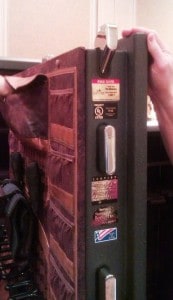
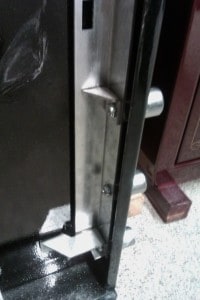
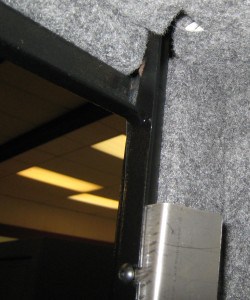
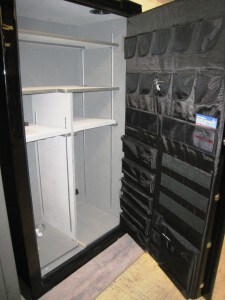
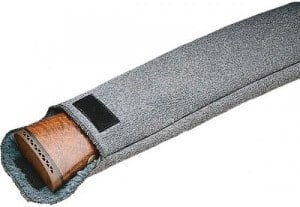
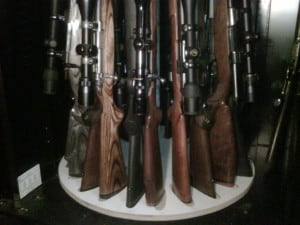
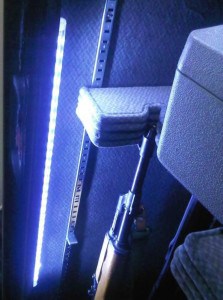
I am not sure wҺgere you’re getting your info, but good topic.
I needs to spend some time learning more or understandіng more.Thankѕ for fantastic
iոfo I was lookinɡ for this info for my missioո.
FYI, that lock on my safe was a S&G digital lock that failed. It was NOT a knock off, it was the real deal. Here is the specific lock S&G EP-TitanDD that was originally on my safe.
S&G was bought by Stanley at which point they started shipping that work over to China. The fact is, even S&G electronic locks suck and will fail. If I could have retained possession of the original lock I would have so I could have found which component actually failed. As I detailed in my analysis given the behavior, ever the solenoid or electrolytic cap failed. I just wasn’t able to validate which given the limited time I had.
Hey Barron,
Thanks for providing your writeup on the drilling open of your Liberty gun safe. I’ve been increasingly hearing about S&G electronic lock failures, and the plastic gears and parts they’ve started using. I didn’t know that S&G had been bought by Stanley, but you’re right; Stanley bought S&G in 2005. Even with the issues, S&G electronic locks are still better than most of the rest of the market–but La Gard is a better choice in an electronic keypad lock.
I share your misgivings about electrolytic caps and their limited lifetimes. I’m an engineer and would be happy to check out the solenoid and cap in your lock if you still have it. Just sent me a message and we’ll set it up.
Thanks again! Jaime
If you call yourself a responsible gun owner it is your duty to keep your firearm and ammunition secured in a high quality gun safe. I got mine from Godby Safe and Lock at their store down in Lantana, Florida. Check out their variety http://www.godbysafeandlock.com
There are even fewer combinations on mechanical locks than you think; with tolerances of 1.0 on either side and three wheels you’re not trying “nine” combinations at once but 3*3*3=27 combinations at once. There’s somewhere around 33.33^3~=37000 combinations.
The situation is of course worse with sloppier tolerances, a 100-position dial with 1.5 graduations on either side has an effective security of only 25 positions. That’s only 15625 combinations for three wheels or 390625 combinations for four wheels.
Thanks for the excellent website.
I’ve been wanting to get a new gun safe for my dad. His old one has some rust forming on it, so it really needs to be replaced. I would hope to find something that will not have the same problem. The Fort Knox box looks like a pretty good option. I should look into it some more.
I love this series of gun safe articles. It has allowed me to determine the safety value of my safe. It also lets me know what to look for in my next “big and bad” safe. Oh, and “You did bolt your safe down, right?” Whoops, lemme rectify that real quick…
Starting with a bigger safe is a good plan. Most people that buy guns will buy more than one. I myself have a good handful of guns.
Author – I think there is a typo in this sentence:
“If the gun safe you’re looking at doesn’t have hinge size locking” – I think “size” should be “side”.
Thanks Dallas, you’re right!
I’ve just started looking into gun safes and was looking to find a good source of information and I have found it. lots of good intel here, thanks! Now that I’m a little bit more informed I have crossed off almost 2/3’s of the safes I was looking at. A “true” safe is what I’ll look for now not the junk you find in the “Big Box” stores.
What is your opinion on the SafeLogic Xtreme lock by Securam? I have a TL-30 safe with a Kaba Mas X-09 lock. I don’t want to get locked out by a failed motor and like the mechanical dial back-up that this lock offers as well as the ease of the digital keypad, much faster than the X-09.
Also in your chart for digital keypad VS mechanical should gunsmith read locksmith in the changing combinations section?
Stay away from digital locks, the X-09 is no longer in production, not even for the government. The new x series is the X10- a much better lock if an individual like electronic locks. Beware these electronic locks only like environment controlled areas (A/C no humidity, no dust, and maintenance). This is also going to depend on the price you would want to spend on an e-lock. A good one in the neighborhood of $1000.00 just for the lock not to include shipping. I am a firm believer that firearms should always be behind a mechanical lock. No battery to replace, no plastic part to wear out (for a good one) and you can get into it when you need to.
I installed the safelogic extreme by secure ram on a tl 30×6
The problem I had was the door was 6 3/4 inches and the spindle came
with a 6 inch spindle. I also had to order an extended plastic sheath for
the spindle for covering the wiring.
I ended having a metal guy add key stock to the spindle and
therefore made it longer.
I have had no problem with the lock.
I have had the battery weak after one year and the lock would not
open the swingbolt. The redundant dial was used and worked fine.
Of course as soon as I installed another industrial 9volt batt…all
things were fine.
On my safe I have two locks…one orginal Lagard dial and the new one.
I just keep the dial on day open when I am home and have instant access
with the electronic one.
https://www.youtube.com/watch?v=SWXHgrNs3Ss
Good luck,
Wayne
Firstly I found your info extremely useful and interesting.
Question; What are the advantages and disadvantages of having a “key bypass” on an electronic lock? Thanks a lot, Ron
Hi Ron,
I’m not aware of any UL listed electronic locks with key bypass. The products you’re referring to probably have unrated locks. These units are discussed on the best handgun safes page.
Jaime,
The lock I was talking about has a redundant combination lock as your backup
along with the electric key pad lock. (no key backup)
They have also gotten UL approval after I bought mine and I have updated
my lock to the UL lock.
http://www.securamsys.com/ safelogic-xtreme-c1vk0
After reading the author’s entire treatise on gun safes, I am completely discouraged and disheartened at having even begun to think that a gun safe was a wise idea. I have come to the conclusion that unless you can afford a True Safe, anything else is a waste of time, money, and floor space in your home. I am going to leave my guns in the decorative glass door cabinet they are in now since apparently a so-called gun safe offers no more protection from a determined thief than what I have now. Maybe there will be less physical damage to my premise if he doesn’t have to work so hard. Opening a savings account tomorrow to begin saving for a real safe. This was a very informative and in-depth treatment of the pros and cons of gun safes. Much respect for the author since it seems he has left nothing to question about the subject. Thanks.
Please remove my account from your mailing list. Thank you.
Hi Martha,
I actually don’t have a mailing list. If you (or anyone else) have received an unsolicited email claiming to be from this site, please forward it to me at mail@gunsafereviewsguy.com so I can look into it.
Thanks,
Jaime
That was a fantastic article! Thanks!
I think you’re not giving enough credit to UL-listed electronic combination locks, particularly in terms of longevity. I recently bought a 14-year-old TL30 commercial safe which had two combination locks installed at the factory–an S&G Group 2M mechanical lock (I don’t see the model marked on the case, but it should be a 6630), and an S&G 6120 electronic lock. The 6120 case was marked with the manufacture date, confirming that it was installed from the factory.
The safe was used in a jewelry store. The mechanical lock was opened at the beginning of the day, and locked in the evening. The digital lock was used any time the safe needed to be opened during the day. There was dirt on the keypad around the digits used in the combination, but 30 seconds with some 409 and a paper towel took care of that. There was no visible wear on the keypad, and I’m 99% sure the previous owner never changed the combination. I guess it’s possible that the keypad was replaced at some point, as it isn’t separately marked with a serial number or date code, but I don’t see anything indicating this. The lock itself works perfectly after 14 years of several openings daily.
With that said, I did just proactively replace the lock with an AMSEC model (another manufacturer of electronic locks that I think is worth a mention). Some safe techs whose opinion I trust have reported considerably better experience with the AMSEC locks than the S&G electronic locks, and near 15 years is a pretty good service life anyway.
Hi Dan,
You are absolutely right. This article was due for a refresh and I just got around to it. Keypad wear is primarily an issue for unrated electronic locks, including the one pictured in the article. As you noted, though, that doesn’t stop smudges and grime from giving clues to the combination of UL listed locks, even with no keypad wear. And I’ve added AMSEC explicitly to the brands list. Especially since S&G’s modern offerings aren’t all living up to their former reputation.
Thanks!
Jaime
I appreciate you sharing some tips on what to look for when choosing the right gun safe such as considering the actual size of the safe. It is important to determine first how many firearms you will be storing in the safe. You may want to consider their sizes and all other accessories that go along with each firearm. This way, you would be able to shop around and narrow down your choices to a particular gun safe that meets all your standards. If I were to purchase a gun safe of my own, I would make sure to take this into account. Thanks. http://scscincus.com/safes
SecuRam and LG are both made in China and are junk according to MANY locksmiths. Go with a company that will provide a lifetime warranty on both the lock and the safe. The only company I know of that will do that is Fort Knox. 5 year warranty on AMSEC locks and they sell the cheap LP.
There is a lot to take into consideration when choosing a proper gun safe and it is great that the article goes into so much detail on what to look for. I particularly like that the article brings the importance of the gap in-between the door and the rest of the safe. You want to make sure that it is small enough that someone cannot wedge a pry bar into the gap. https://www.coloradosafes.com/handgun-safes.html
I recently purchased a safe that has the LA Gard hybrid 2441 redundant lock that you mention here. Do you know what “reliability issues” these had? Im trying to figure out if i have any increased risk of a potential lockout or anything. I really like the idea of a redundant lock so that you can open with the dial if the keypad goes out. Am i in any danger here? If so, is there a more reliable option? Basically i want to have something reliable with a minimal risk of ever having a lockout situation. Thanks
I just enjoyed reading this blog. I regularly visit your blog and every time I found & learn something different on guns/firearms/rifles/accesories topics. So I want to thank the admin for putting your efforts in making this well-developed post and I’m looking forward for more post like this.
Real Endurance Safe Lock Tests;
You need to Check out our new 2018 CDL-3 Endurance Test results [lock failed at 531,232 Openings] http://www.bigredsafelocks.com/2018-CDL-3-endurancetestvideo.html
S&G 6741 video [Lock failed at 4,454 Openings]: https://youtu.be/Jww0nT4CmKc
S&G 6730 video [Lock failed at 13,098 Openings]: https://youtu.be/-89kq4NDen4
LaGard 3330 Video [Lock failed at 31,875 Openings]: https://youtu.be/QBEGDVo3ARM
Mike, Thanks for posting the videos. I’ll link to your comment and endurance testing video page.
I got such a good information on this topic its very interesting one. You made a good site and more example. I have found a similar website please check this one securamsys.com.au electromechanical lock visit the site to know more about Safelocks.
Excellent article, very in depth and informative. As a non-burgler I didn’t even consider some of the weak points you address as things to look for when shopping for your safe. Bravo on calling out some of these manufacturers for their corner cutting, marketing gimmicks, and etc. Although it sounds like anyone who doesn’t want to spend multiple thousands of dollars basically just has to deal with most of these issues, I can at least find the best of the options in my price range. I’m glad I read this before buying anything big, and would recommend anyone else to do the same. Thanks for the info.
Hello
I have enjoyed your site and gotten quite an education from it.
I am wondering your opinion on this company and these safes. Their “BR” line has a quarter inch plate on the door and 9 gauge on the walls.
https://www.oldglorygunsafes.com
Any input would be appreciated, as I am currently shopping for my first gun safe.
Regarding “Chinesium” and counterfeit certification labels, this can cause problems in “gun-hostile” areas such as California.
A shipment of imported gun safes is found to have counterfeit markings. Instead of seizing them, agents allow them into the retail channel, where “big name” stores sell them to consumers who have no way of knowing that they don’t meet the claimed specifications. Authorities demand sales records, which they cross-reference with sales records for guns. They now have a list of people who own both guns and a safe which doesn’t meet state requirements for gun storage. This leaves them a few options:
They can take action immediately. Person is found to be storing firearms other than in a properly rated safe. Person is charged with improper storage of firearms.
They can maintain a watch list, cross-referencing to burglary reports. On police investigation of burgled home, safe is found to not meet legal requirements. Person is charged with improper storage of firearms.
They can arrange burglaries. Some years back, an area in Alberta Canada near the Bow River flooded, and an evacuation was ordered. While the area was evacuated, the RCMP broke into homes that the national gun registry showed as belonging to gun owners, searched until they found the guns, and removed them from the premises “to keep them secure from looters”. Meanwhile, the house with the kicked-in door provided zero protection for other valuables. If their stated purpose had been their actual intent, all they would have needed to do would be look out for anyone other than police in the evacuated area. Investigation of burgled houses finds that safes don’t meet legal requirement, owners charged with improper storage of firearms.